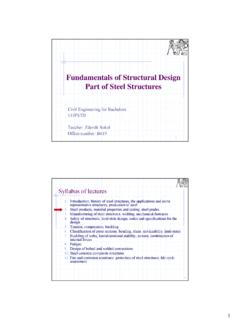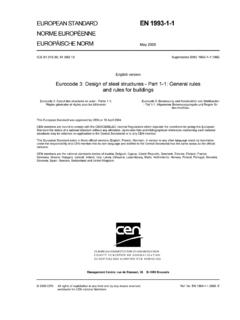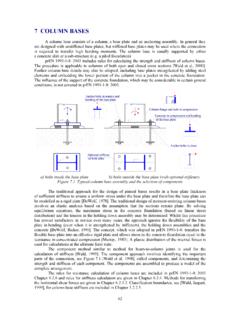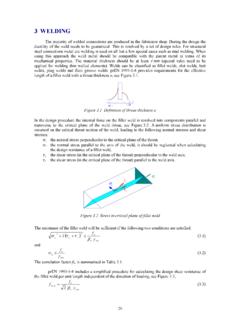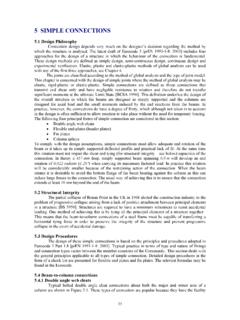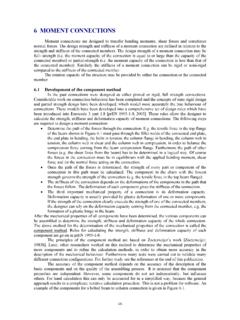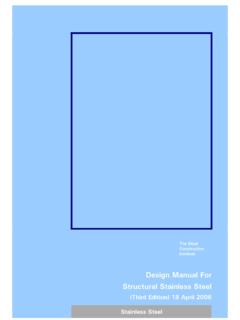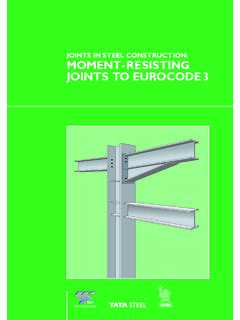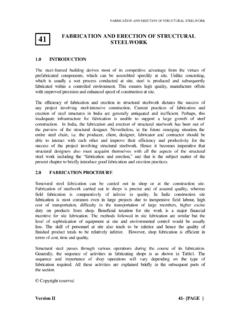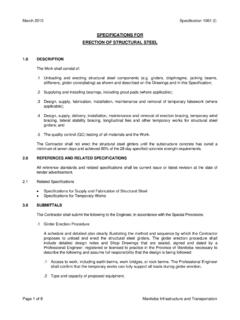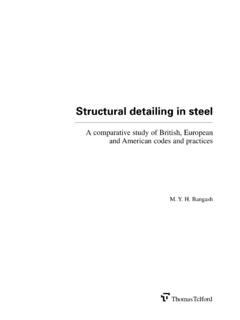Transcription of DESIGN OF STRUCTURAL CONNECTIONS TO EUROCODE 3 …
1 DESIGN OF STRUCTURAL CONNECTIONS . TO EUROCODE 3. FREQUENTLY ASKED QUESTIONS. Watford, September 2003. Building Research Establishment, Ltd. DESIGN of STRUCTURAL CONNECTIONS to EUROCODE 3 Frequently Asked Questions Ed. Moore , Wald F. ISBN 80-01-02838-0. Building Research Establishment Ltd, Watford Printed at Prod. Dept. of Publishing House of Czech Technical University in Prague September 2003. 1500 copies, 140 pages, 154 figures Textbook, Work Package Dissemination Project Continuing Education in STRUCTURAL CONNECTIONS No. CZ/00/B/F/PP-134049. LEONARDO DA VINCI PROGRAMME. This project has been carried out with the support of the European Community. The content of this project does not necessarily reflect the position of the European Community or the National Agency, nor does it involve any responsibility on their part.
2 LIST OF CONTENTS. Page 1 Introduction .. 6. 2 Bolts .. 10. Q&A Loss of Bolt Pre-Load .. 12. Q&A Bearing of Slip Resistant CONNECTIONS .. 12. Q&A Shear Resistance of Pre-Loaded Bolts Carrying a Tension Force .. 13. Q&A Maximum Bolt End and Edge Distances .. 13. Q&A Deformation Criteria for Bolt Bearing Resistance .. 14. Q&A End and Edge Bolt Distances .. 15. Q&A Bearing Resistance of Bolt Group .. 15. Q&A Bearing Resistance in Slotted Holes .. 16. Q&A DESIGN Method for Fitted Bolts .. 17. Q&A Combined Shear and Tension .. 18. Q&A Resistance of CONNECTIONS Using High-Strength Steel .. 19. 3 Welding .. 20. Q&A Connecting Two Angles to Gusset Plate .. 22. Q&A Effective Width of Welded Beam-to-Column Connection .. 23. Q&A Throat Thickness of a Fillet Weld used in a Hollow Section Joints.
3 24. Q&A Modelling the Resistance of a Fillet Weld .. 24. Q&A DESIGN of Partially Penetrated Butt Weld .. 25. Q&A Weld DESIGN for Full Resistance of Connecting Members .. 26. 4 STRUCTURAL Modelling .. 27. Q&A Preliminary DESIGN of CONNECTIONS .. 29. Q&A Use of Elastic Theory for Global Analysis of Structures .. 29. Q&A Classification Criteria for Column Bases .. 31. Q&A DESIGN of CONNECTIONS Loaded by Low Forces .. 32. Q&A Modelling of Joint Eccentricity in Frame DESIGN .. 33. 5 Simple CONNECTIONS .. 35. Q&A Bolt Bearing Resistance with Respect to Tolerances .. 41. Q&A Angles Connected by One or Two Bolts .. 42. Q&A Rotation Capacity .. 43. Q&A STRUCTURAL Integrity .. 44. 6 Moment CONNECTIONS .. 46. Q&A Stiffness Modification Coefficient for End-Plate CONNECTIONS .
4 49. Q&A Effective Length of Stiffened T-stub .. 50. Q&A Haunched CONNECTIONS .. 51. Q&A Diagonal and K-stiffeners .. 51. Q&A Yield line Patterns for End Plate Connection with Four Bolts in a Row .. 52. Q&A Distribution of Forces in a Thick End Plate Connection .. 53. Q&A Distribution of Shear Forces in a Bolted Connection .. 54. Q&A Prying Force of T-stub in Fatigue DESIGN .. 54. Q&A oints Loaded by Bending Moment and Axial Force .. 56. Q&A Stiffening of the Column Web Panel with a Morris Stiffener .. 60. Page 7 Column Bases .. 62. Q&A Elastic Resistance of Base Plate .. 63. Q&A Base Plate Resistance with Low Quality Grout .. 64. Q&A Comparison of Concrete Strength Calculation according to EC2 and EC3 64. Q&A Stress Concentration under the Base Plate.
5 66. Q&A Effective Length of a Base Plate T-stub .. 67. Q&A Base Plates with Bolts outside the Column Flange .. 69. Q&A Slip Factor between Steel and Concrete .. 71. Q&A Transfer of Shear Forces by Anchor Bolts .. 72. Q&A Transfer of Shear Forces by Friction and Anchor Bolts .. 73. Q&A Anchorage Rules for Holding Down Bolts .. 73. 8 Seismic DESIGN .. 76. Q&A CONNECTIONS Subject to Dynamic Load .. 80. Q&A Influence of Unsymmetrical Loading .. 81. Q&A Influence of Strain-Rate Loading .. 81. Q&A Welding Technology .. 81. Q&A High Strength Bolts in Seismic Joints .. 82. Q&A Column Web Panel .. 83. 9 Fire DESIGN .. 84. Q&A Bolts Resistance at High Temperature .. 84. Q&A Weld Resistance at High Temperature .. 85. Q&A Temperature Distribution with Time within a Joint.
6 85. Q&A Component Method under High Temperatures .. 87. 10 Hollow Section CONNECTIONS .. 90. Q&A Circular Hollow Section Joints .. 92. Q&A Rectangular Hollow Section Joints .. 94. Q&A Joints between Hollow and Open Section Members .. 96. Q&A DESIGN Charts .. 98. Q&A Blind Bolting .. 100. Q&A Hollow Section Joints using High Strength Steel .. 102. Q&A Offshore Construction .. 102. 11 Cold-Formed CONNECTIONS .. 103. Q&A Increased Yield Strength by Cold-Forming .. 108. Q&A Deformation Capacity of Shear CONNECTIONS .. 109. Q&A Screws in Sandwich Panels .. 109. Q&A Bearing of Thin Plates .. 110. 12 Aluminium CONNECTIONS .. 111. Q&A Resistance of Fillet Welds .. 111. Q&A Effective Width and Throat Thickness of Fillet Welds .. 112.
7 Q&A Butt Welds in Aluminium Joints .. 113. Q&A Heat Affected Zones .. 114. 13 Good and Bad Detailing .. 117. 14 Lessons on Internet/CD .. 123. 15 Text of PowerPoint Lesson on the DESIGN of CONNECTIONS for Fire Safety . 125. List of Symbols .. 128. References .. 134. 1 Introduction Developments in the DESIGN , fabrication and erection of steel structures together with the introduction of new high performance materials have lead to significant changes in the DESIGN , buildability and performance of steel structures and in particular their CONNECTIONS . Early steel structures used riveted CONNECTIONS but following technological developments shop welded and site bolted CONNECTIONS are now common place. The introduction of high strength steels has increased the types and grades of bolt available to the designer.
8 The range of bolts now includes ordinary strength steels bolts such as grades , and and high strength steel bolts such as grades , and Developments in automatic fabrication have seen a move away from manually produced drawings and setting out to sophisticated DESIGN software directly connected to numerically controlled machines for laser cutting, punching and drilling. The quality of welding has also improved with the introduction of continuous casting of steel and welding robots. These changes and in particular the increase in the use of automated DESIGN and fabrication have lead to an increase in quality and standardization in comparison with other STRUCTURAL materials. Today steel CONNECTIONS are economical to fabricate and erect, have a high inherent level of safety and can help the architect produce elegant and practical structures.
9 To take advantage of the wide range of steel products and technological developments that exist within the different European countries, the European Union created a set of common DESIGN standards for the DESIGN , fabrication and construction of steel structures. These standards are called the Eurocodes and have been developed over many years to take advantages of the different techniques available within the different member states. At the time of writing the Eurocodes are still pre-standards [ENV 1992-1-1, 1992; ENV 1993-1-1, 1992; ENV 1999-2, 1999] but within one or two years they will be converted to full Euro-norms that will eventually replace the existing National codes [prNV 1992-1-1, 2003; prEN 1993-1-2, 2003; prEN 1993-1-8: 2003].
10 At the inception of the EUROCODE for steel structures ( EUROCODE 3) the importance of STRUCTURAL CONNECTIONS was recognized and a specific standard for the DESIGN of steel CONNECTIONS was created. This standard is part of the main steel EUROCODE and is called prEN1993-1-8 - DESIGN of Joints. As part of the development of the early versions of EUROCODE 3, background documents were prepared summarizing best practice in the DESIGN and use of bolts and welds [see Snijder and ]. Furthermore, the DESIGN models for each of these components was validated against available test data before being included in the European standard. Traditional DESIGN methods for CONNECTIONS were based on a series of capacity checks and did not include methods for calculating a connection's stiffness and rotational capacity.
